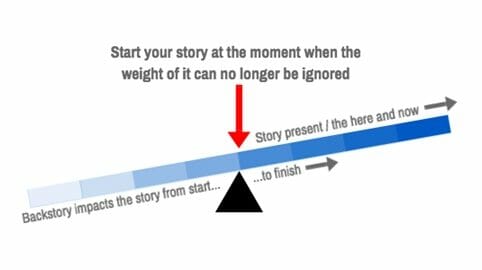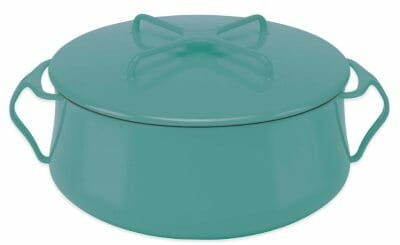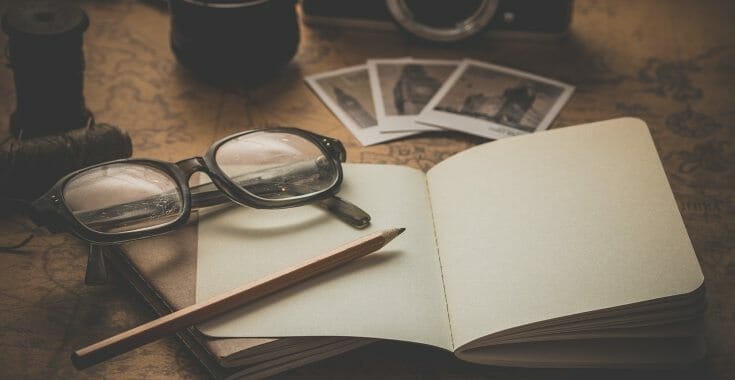My mission as a book coach is to help writers write the best books they can, which means paying attention to:
- the macro elements (the story or argument the book makes)
- the micro elements (the words on the page)
- the emotional realities of the writing life (the habits that lead to success)
I’ve developed a series of posts to help you learn how to write one really great chapter so that you can take those lessons and apply them to all your work.
- Post 1 – Yank Your Reader Into Your Story With a Great Opening Line
- Post 2 – How to Start Your Story in the Right Place
- Post 3 –How to Get the Story Out of Your Head and Onto the Page – a Lesson on Shaking Off the Burden of Knowledge
- Post 4 –A Little Lesson in Dialogue
- Post 5 – Mastering the Art of the Scene
Several weeks ago, I wrote a post about the best place to start a story and I shared this graphic:

You can plainly see that backstory is not just the stuff that happened before we got to the story. It’s part of the story. It’s baked into it. What happened before colors everything that happens now. This is true in our own lives and it’s true in fiction, as well. You need to understand how backstory works in order to write a seamless story that captures a readers’ attention.
How Backstory Works
Let’s take a look at how it works in our own lives.
The other day, I was watching Michel Pollan’s “Cooked” on Netflix, a series based on the book of the same name, about how cooking transforms humans. Watching with me were my husband and our college daughter’s boyfriend, Jon, who had just arrived to live with us while he completed an internship. Episode #2, Water, starts with the image of a Dansk brand Dutch oven:

My mind instantly went to an image of my mother making spaghetti sauce in a pot just like that, and said, “My mom had that pot in yellow!”
My husband said, “My mom had one that was white” –- and indeed, we had the baking pan companion to his mom’s white pot in our kitchen cabinet; it was a beat-up thing, battered but still going strong.
My husband and I were both instantly awash in memories of our mothers and the foods they cooked and their kitchens and our childhood, and we both later confirmed that we were also instantly thinking about the dark blue Le Cruset Dutch oven we bought on a road trip when we first listened to Michael Pollan narrate his book and how we had the belief that this pot would outlive us, and that our kids would fight over it because it represented something central about who we were: people who believed in sitting down together for dinner each night.
Our memories led us to action – which is the critical thing for storytellers. No one wants to read a whole book where the characters sit around musing about their mothers and spaghetti. The action in our case was this: The next day, we got down some cookbooks, planned out a meal centered around the Dutch oven, and made a whole evening out of inviting Jon into a ritual that we felt defined us a family. That action set the stage for the three of us to cook together for the next few months, an activity that would prove to be both bonding and fun. Our blue pot, in other words, was a gateway, an invitation for an outsider to come in.
The point is that the image of the blue pot was not neutral. We were filled up with memories triggered by the pot. Our memories led us to an action. The action moved our story forward.
And yet Jon had never seen a pot like Michael Pollan’s blue Dansk Dutch oven. His mother did not have this pot. To him, the photo on the screen was just a cinematic exercise in getting the viewer to think about cooking things with water and the fact that you needed a pot to do that.
But it’s important to note that the Dansk pot wasn’t without meaning to Jon. The camera lingered on the pot. It was a “hero’s shot” of the pot. He recognized the fact that the filmmaker wanted him to pay attention to the pot, and he attached meaning to it based on the information he had at hand: this was a documentary about cooking, the theme was water. The meaning he made was there, but it had no specific memory attached to it.
All of this has to do with the idea of backstory in fiction, because the point is that nothing is neutral. No one looks at a blue pot and thinks nothing. You might think, “I always hated Mom’s spaghetti,” or “Nice lighting on that hero shot” or “Love that color blue” or “That weird handle reminds me of a pipe wrench” but you think something.
The same is true of your characters. And this is what backstory is – the events that happened prior to Page 1 that we bring into the story and use to make meaning of it.
Backstory, in other words, is always triggered by something in story present – a blue pot, a Madeline cookie (made famous by Proust), something someone says or does.
And it always changes the landscape of what is happening. It has an impact. It does something to the person experiencing it. Otherwise, why bother to tell your reader about it?
Backstory Guidelines
Let’s look at some Do’s and Don’ts so you can wrap your mind around how this works.
- Do weave backstory into your narrative throughout. It can be a line or two, a paragraph, a whole scene, but it needs to be there.
- Do not leave backstory out of the story, because life doesn’t work like that, and memory doesn’t work like that. Unless you are writing about someone who doesn’t have a memory, people have memory. They see the world through the lens of their experiences. Pretending otherwise is to rob your story of a large part of its meaning.
- Do use backstory to help your character make a point, make a decision, or make sense of their journey.
- Do not insert a piece of backstory that just sits there doing nothing, leading to nothing, causing nothing to happen.
- Do remember that your reader is smart. They know what fits organically and what has been crammed in.
- Do not insert a random piece of backstory into a narrative because you want the reader to know this information.
- Do remember to bring your reader along on the journey of the backstory – particularly if it’s a lengthy passage. Invite the reader to it with language that leads them into the past; show them the reason why you are diverting them from the main story (i.e. what it all means); and lead them back to the main story with language that guides them firmly back into the flow.
- Do not expect them to follow where you are taking them if you don’t give them a roadmap. You can’t make the reader guess the meaning of what you are telling them. You have to make it clear.
These simple guidelines will help you pick up little bits of backstory and weave them into your story at every turn, and they will help you when you want to go back in time for a really big and powerful revelation, as well.
Backstory Examples
Below are two examples from a middle grade novel and a classic American tale of greed.
Excerpt: From the Mixed-Up Files of Mrs. Basil E. Frankweiler by E.L. Konigsburg
Claudia knew that she could never pull the old-fashioned kind of running away. That is, running away in the heat of anger with a knapsack on her back. She didn’t like discomfort; even picnics were untidy and inconvenient: all those insects and the sun melting icing on the cupcakes. Therefore, she decided that her leaving home would not be just running from somewhere but would be running to somewhere. To a large place, a comfortable place, an indoor place, and preferably a beautiful place. And that’s why she decided upon the Metropolitan Museum of Art in New York City.
In these opening lines of the wonderful middle grade book about running away, Konigsburg weaves in backstory seamlessly and powerfully. In the yellow highlighted section, Claudia is telling us something critical about herself – the fact that she doesn’t like discomfort. The author uses backstory to do this – just a little snippet of a memory of a picnic and cupcakes. In just two lines, we get this character, the girl who didn’t like picnics. We also get a sense of the kind of life she is running away from; sun melting on cupcakes at a picnic paints a picture of a loving family, a caring family, a happy family and so it’s clear that this is not a story about childhood trauma, but regular childhood struggle.
In the green highlighted section, the backstory is more subtle, but it’s absolutely there. From Claudia’s description of the museum – large, comfortable, indoors, beautiful – we know she has been there before. We guess that she has probably been on more than one occasion; she knows this place. In fact, she considers it safe, inviting, her place. The author doesn’t have to tell us that Claudia went there every Sunday with her family in June, or that she went on every year with her classmates on a field trip, nor does the author have to describe the museum itself (i.e. how many square feet, how many visitors, how many works of art); she just has to let us see the museum through Claudia’s eyes.
The impact of the backstory on the story itself is crystal clear here: because of Claudia’s specific dissatisfactions with her picnic-loving family and her desire for comfort, beauty and peace, she is going to run away from home. In just one paragraph, the reader is primed to wonder: how will that go? Will she find comfort, beauty and peace? Will she miss the family who picnics in the sun? This is exceptionally powerful writing.
Excerpt: The Great Gatsby by F. Scott Fitzgerald
In my younger and more vulnerable years my father gave me some advice that I’ve been turning over in my mind ever since.
“Whenever you feel like criticizing any one,” he told me, “just remember that all the people in this world haven’t had the advantages that you’ve had.”
He didn’t say any more, but we’ve always been unusually communicative in a reserved way, and I understood that he meant a great deal more than that. In consequence, I’m inclined to reserve all judgments, a habit that has opened up many curious natures to me and also made me the victim of not a few veteran bores. The abnormal mind is quick to detect and attach itself to this quality when it appears in a normal person, and so it came about that in college I was unjustly accused of being a politician, because I was privy to the secret griefs of wild, unknown men. Most of the confidences were unsought—frequently I have feigned sleep, preoccupation, or a hostile levity when I realized by some unmistakable sign that an intimate revelation was quivering on the horizon; for the intimate revelations of young men, or at least the terms in which they express them, are usually plagiaristic and marred by obvious suppressions. Reserving judgments is a matter of infinite hope. I am still a little afraid of missing something if I forget that, as my father snobbishly suggested, and I snobbishly repeat, a sense of the fundamental decencies is parcelled out unequally at birth.
In these opening lines of the classic novel, Fitzgerald starts everything with backstory. We are dropped into the mind of a man who is recalling some advice his father game him in his youth, when he was a different man than he is now – younger, more vulnerable. We instantly understand that the narrator has been hardened by whatever has happened to him – and we want to know what it is that happened and what being hardened cost him.
The very specific memory of what his father said to him gives way in the green highlighted passage to a more generalized bit of backstory – a description of the author’s relationship to his father, and the author’s understanding of what his father’s advice meant to him throughout his life and as it pertains to what we are going to be told in this story.
The blue highlighted passage returns us to another season in the author’s life, where the impact of his mindset – and his reason for sharing it with us — becomes clear: he is a man who is going to be snared by someone who had an entirely different set of advantages than he did. Note the use of words like “and so it came about,” “now” and “still” to help us move in and out of the backstory.
Analyze Your Own Work
Take a few pages of your own work, or an entire scene or chapter, and analyze it in this same way. Mark the subtle and overt instances of backstory. Evaluate why they are there — what they add to the story — and how you move in and out of them. By paying such close attention to the flow of the back-and-forth narrative, you will improve your understanding of how backstory works, and learn how to write it with more power and purpose.
Photos: Bed, Bath and Beyond, and pixabay.com


